Antique French SFBJ 301 Paris dolls have some doll collectors a bit confused. Many versions exist and I have just started learning them. I would like to introduce you to some that arrived at my door this year all the way from France. SFBJ stands for the Société Française des Bébés et Jouets, the name of the corporation that swallowed up many well known prosperous French doll companies at the end of the 19th century. Some of them included the famous Jumeau and Bru Jeune et Cie companies.
Two of the larger SFBJ 301 dolls in my photos here have the Jumeau paper label because SFBJ bought out the rest of the Jumeau stock. If you are a fan of the early well made Jumeau doll body, then the label assures you it is from the Jumeau stock or made from the Jumeau molds that remained when SFBJ took over.
Later SFBJ continued to make the 301 dolls but you don’t see the Jumeau labels or stamps any longer. In fact the quality starts to go down and in the end the 301s appear as poorly constructed papier mache dolls, evidence of the misfortunes of the depression and war in Europe during the time.
Two Early Examples of Older SFBJ 301 Paris Dolls

Above are two dolls with heads marked SFBJ 301 Paris size 9. One is a 21 inches tall and the other is 20 inches in height. The taller 21 inch SFBJ 301 doll has no restoration but the shorter 20 inch has replaced lower legs, drawn red lines at the toes, and restringing.
Comparing the SFBJ 301 Doll Bodies
I wanted to share some photos with you and talk about the differences I observed. Many of us get to see photos of the dolls dressed or images of their faces, but so many doll books forget to show us their marks or bodies. If you are like me and want to understand the doll and identify it well, you need to know their bodies and markings. So let’s compare the two more.
For the two larger earlier SFBJ 301 dolls I have to compare here, the taller of the two stands at 21 inches tall with a 16 inch body and the shorter stands at 20 inches with a 15 inch body. They both have size 9 bisque heads. The shorter one has replaced hands and lower legs from a similar doll body as you should see in the coloring of the finish.
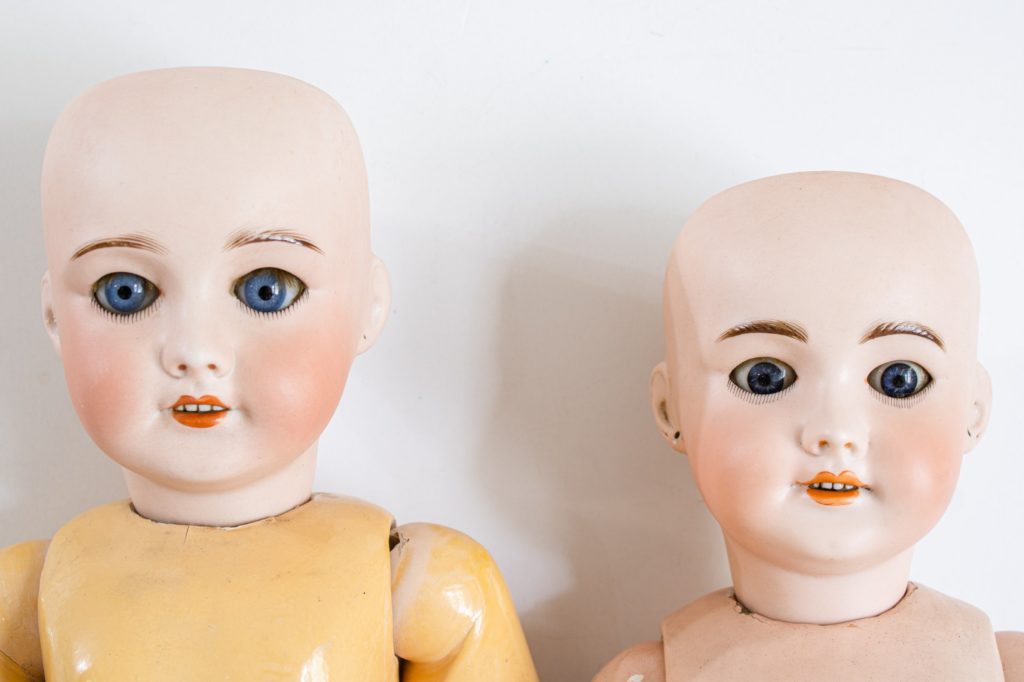
The Torsos and the Jumeau Labels

Both of these dolls in my photographs have the oval Jumeau paper label on their backs which read “Bébé Jumeau Diplôme d’Honneur.” This label first appeared around 1892 and was found on Tete model of Bebe Jumeaus and then appeared on the early SFBJ dolls. You don’t see these Jumeau oval labels on later papier mache SFBJ 301 doll bodies. If you look at the labels carefully you see a difference in the shape and color . The larger doll has a label that appears more round and a darker shade.
Both dolls have a sturdy well made torso, except the taller one in constructed with a crier box inside. Two holes appear on the side of the body with the grommets where the cords used to extend. A child could pull the cord to make the doll cry. This doll’s cords no longer extend out of the side holes. Both dolls have sculpted stomachs showing a navel and chest muscles with a typical toddler type protruding stomach.
One thing to notice is where the hands fall at the dolls’ sides. (See some other antique French doll markings here.)
SFBJ 301 Size 9 Bisque Heads
Though the two dolls are an inch different in height, both have heads the same size. They both carry the circular incise mark that reads S.F.B.J. 301 Paris and the number 9 at the bottom of the neck. The smaller doll though has a red stamp “TETE JUMEAU” across the marks while the taller one also has the incise mark of “FRANCE” and the additional number “25” at the top. Yet the heads have the same circumference for wearing wigs or hats. I had the dolls swap out wigs and both put on the hat to show how they can share these items.
Their sizes only differ in the body proportions. When perusing Theriault’s “The Body Book,” you read that the 15 inch doll bodies were usually a size 8. As an amateur I assume she means size 8 bisque head. Under that assumption, I wonder if the head of the shorter doll is not original to the torso. She may be a 301 Jumeau hybrid which we already see in lower legs. (See, it’s a journey of learning.)
Another difference in the bisque, I noticed, lay in the texture. The TETE JUMEAU stamped head has a smoother more translucent finish easier to distinquish when looking at the back of the head.

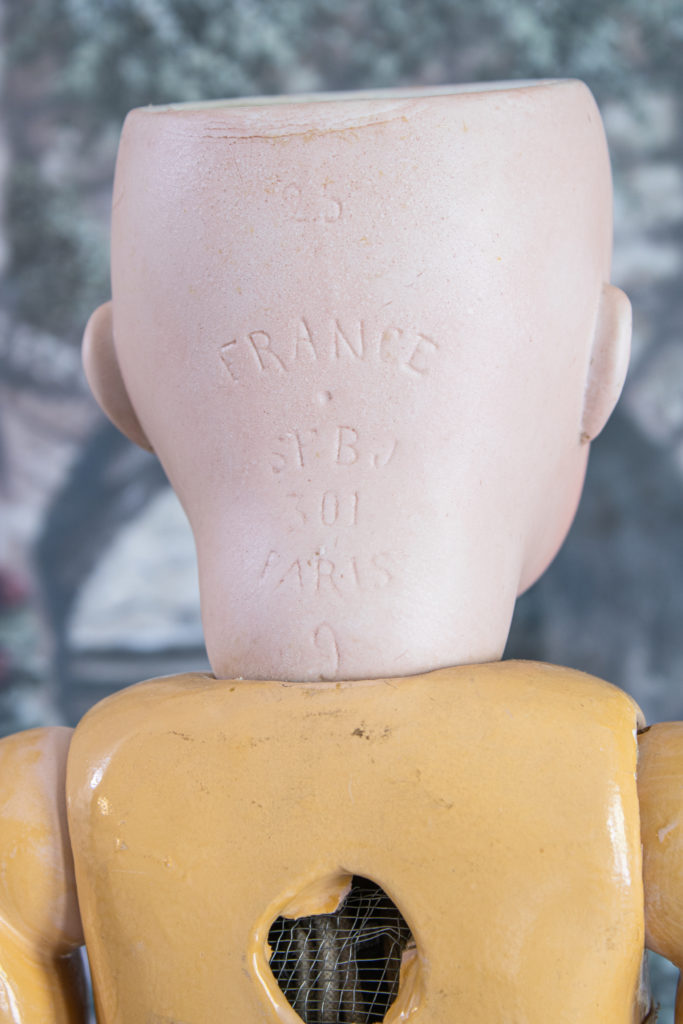
Knee and Elbow Sculpting
When I first began to distinguish between the French and German antiques I noticed the knee joints. The Jumeau doll bodies, like these and many others, have no sculpted knee features, no dimples, not articulated knee muscles that you so often see in German brands. The thigh and and the lower leg meet evenly at the joint. As soon as I see that feature, I think “French doll” or “made for the French market.” The elbow joints resemble the knee joints. Very simply defined where the upper and and lower limbs meet in the outer side of the arm.
The taller doll has no articulation of arm muscles but a line appears where the shoulder’s ball joint starts. The opposite is true for the shorter SFBJ 301 doll in the photo.
Both SFBJ 301 dolls have similar torso sculpting except on has the crier box inside and thus two holes on the side where cords once extended to make to pull and make the doll cry.
Inner Thigh & Upper Arm Sculpting
Both of these SFBJ 301 Paris dolls with the oval label have attached ball joints at the knees, hips, elbows, and shoulders. They have no individually cut ball joints like the earlier Jumeau dolls. If you look at these dolls carefully, you might see articulation in the sculpting of the inner thigh which looks like flabby muscles. On the other hand, if you look at their upper arms, only the shorter doll with the rosy pink finish has this articulation of the muscles in the inner arm. It does not show in the yellow finish of the taller doll.
I noticed that the taller doll has an evident line at the attached shoulder ball joint that the shorter doll doesn’t. The doll with the rosy pink finish has a smooth surface all the way to the edge of the shoulder’s ball joint that the yellow finish doll does not have. It’s a very subtle difference, but a definite feature.
Notice the articulated inner thigh muscles, and at the side of the abdomen. In this view it is easier to see the line defining the shoulder in the taller doll’s arm.
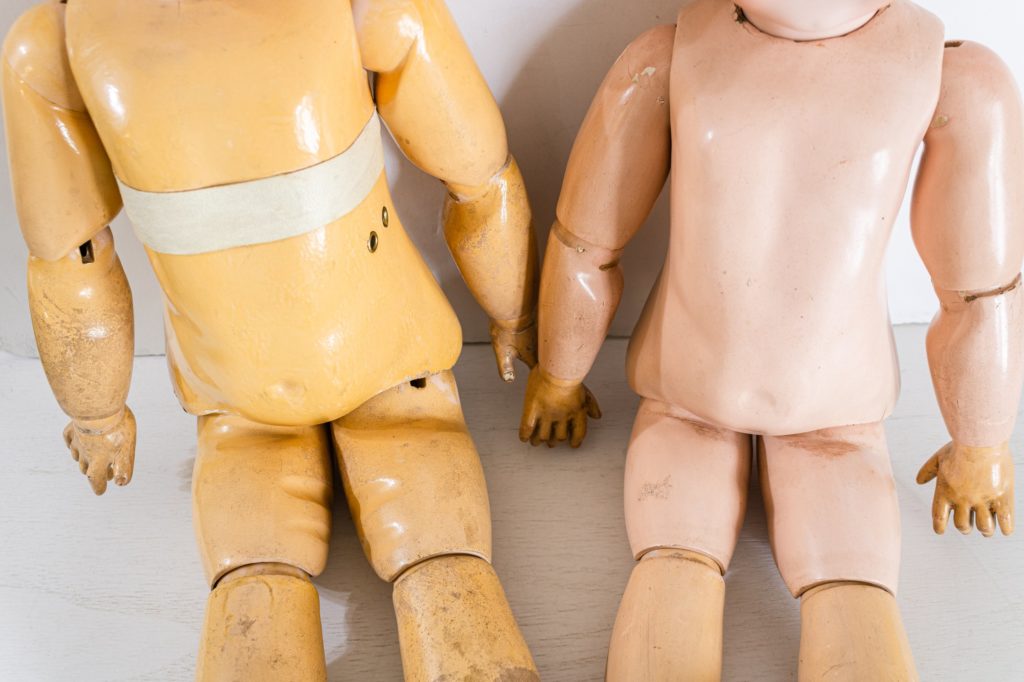
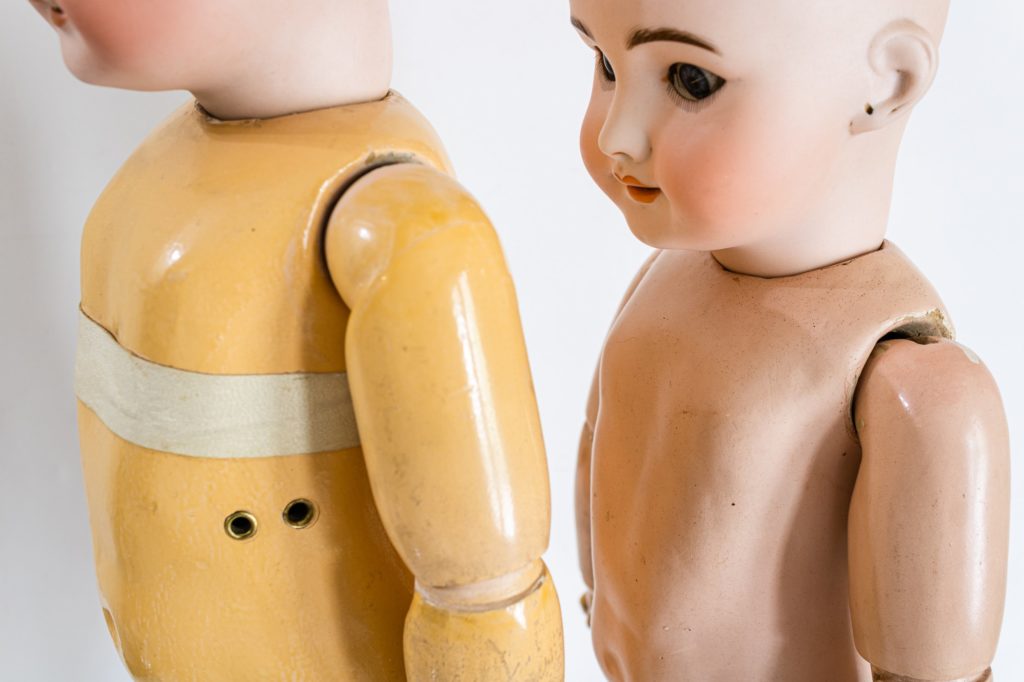
Both size 9 heads can share hats and wigs and have molded eye brows. You can see a darker red paint and darker cheeks on the taller doll. Her eyes are also pushed forward into the eye sockets more. Both dolls have 4 teeth. (I like the paler coloring of the shorter doll more.)
Here the two dolls have switched wigs from the photo at the top of the post, and the shorter doll now wears easily the hat that belongs to her taller friend. I kind of like the wig swap and how it changes their personality. Both dolls came to me with their original brunette curly wigs made of human hair. Neither of the dolls came with a pate.
Later SFBJ 301 Paris Dolls
The SFBJ 301 Paris dolls appear over the years in different bodies. Another early SFBJ 301 doll has what is called a transition body. It does not have the Jumeau paper label. The doll head bears the same circular incised mark and says size 8. The body has more articulation but lacks the earlier Jumeau chunkiness with thinner arms. The lack of the chunky doll body also begins to impact the ease of standing with balance. The face remains the same. This doll below was about 20 inches found locally.

UNIS FRANCE Mark
SFBJ later used the UNIS FRANCE collective mark with its numbers of 71 and 149 instead of the “SFBJ Paris”. The mold number 301 still appears. It is the same 301 mold as those with the SFBJ Paris in the marking. Read more about the UNIS FRANCE mark here.
This Unis France 301 doll wears a traditional French costume and still had her hang tag that reads, “Fabrication Jumeau.”
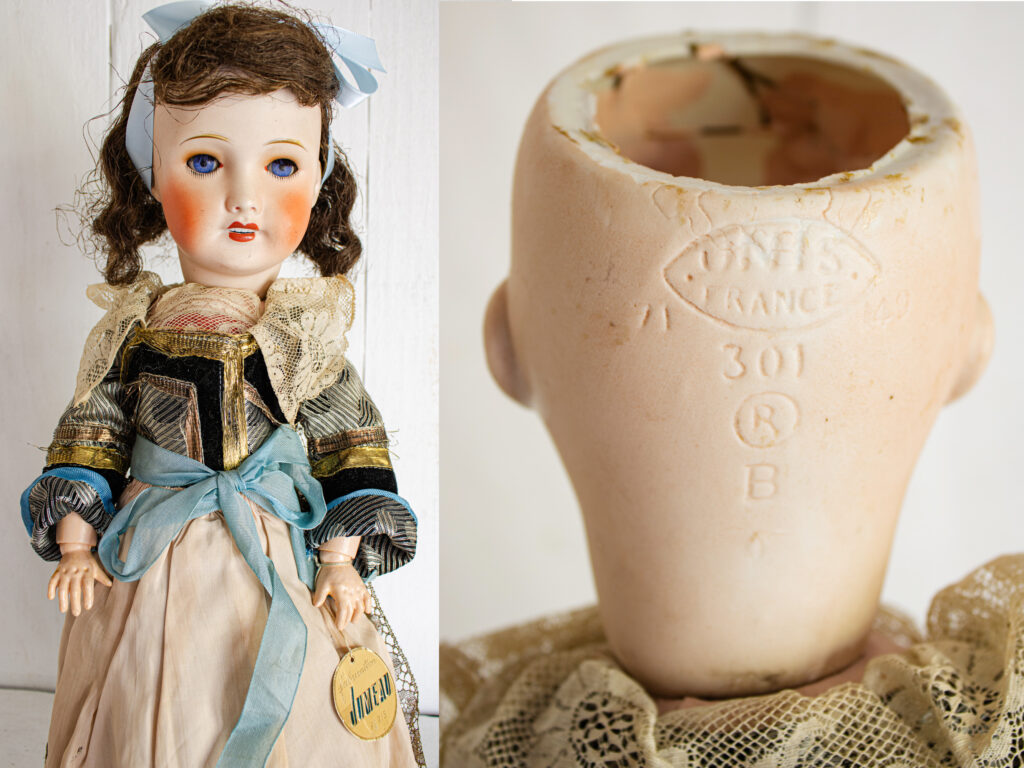
Below, another UNIS FRANCE 301 doll by SFBJ.
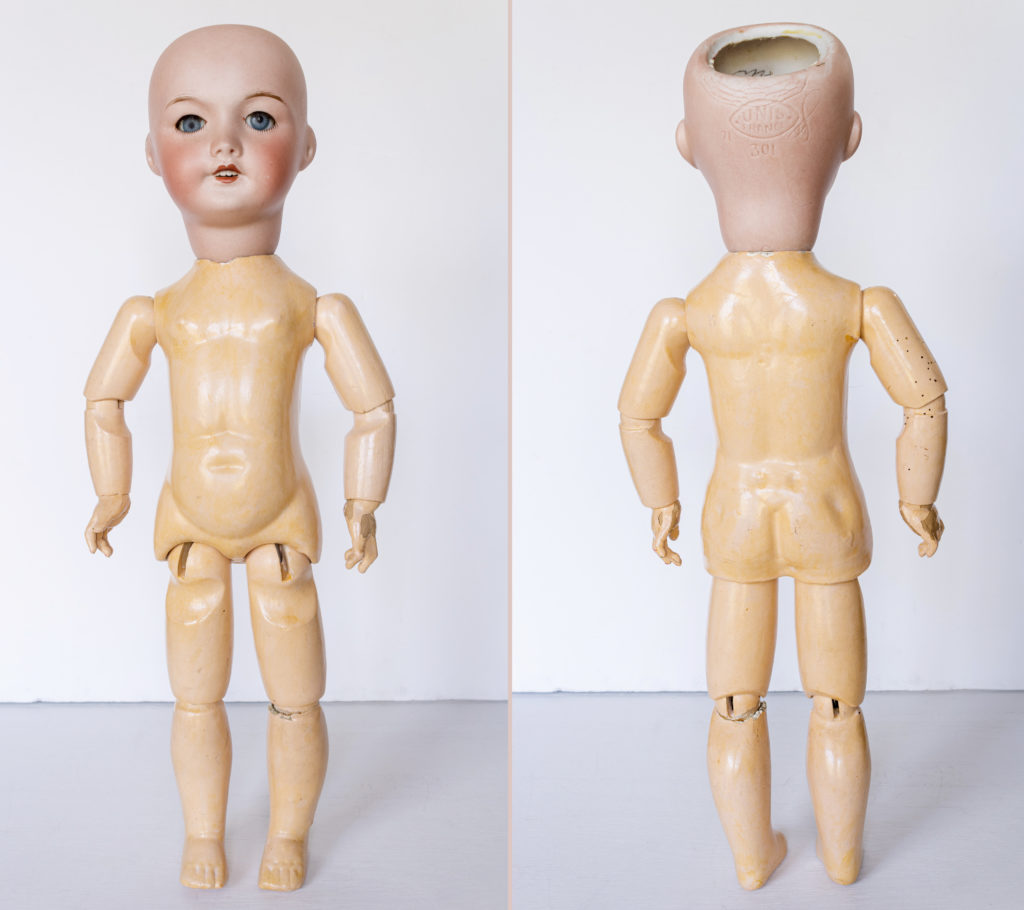
Petit SFBJ 301 Paris Dolls
This girl pictured is one of my favorite finds thus far. She is a nice cabinet size of only 25 cm. Head is marked FRANCE like the tall 21 inch doll pictured above and her head size is a 2/0. The back of her torso has the incised mark 1. The head has a circumference of about 6 inches. She is only 25 centimeters tall.
If she were 2 cm taller she could be Bleuette who had a head size of 1 and a body marked 2.
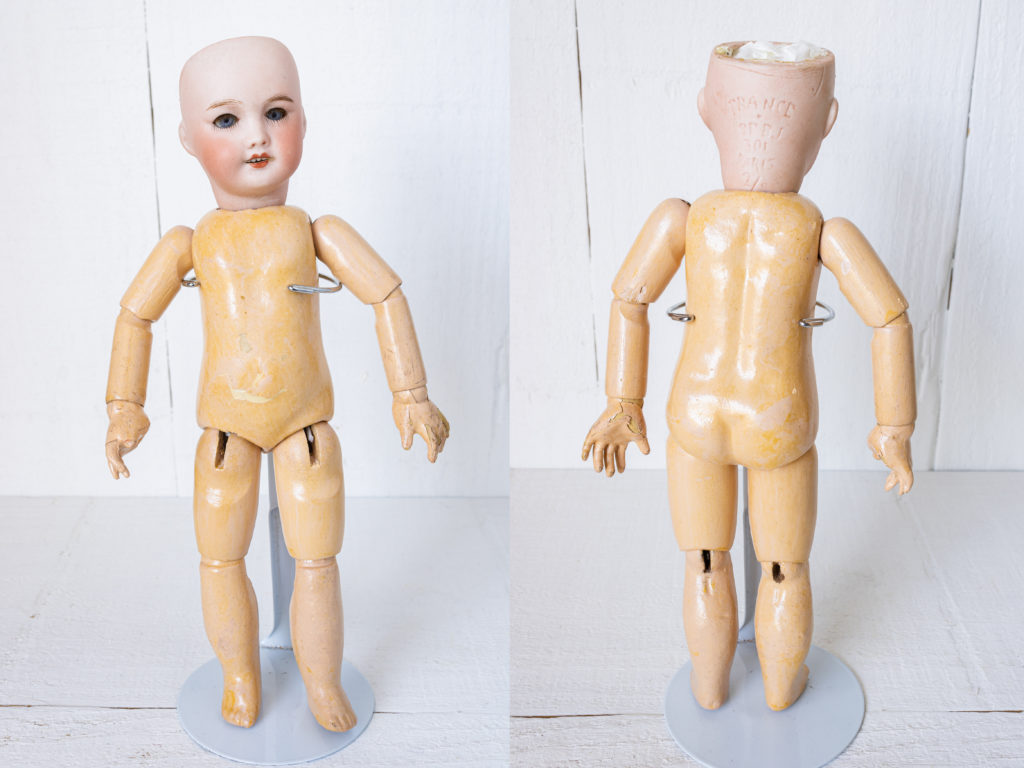
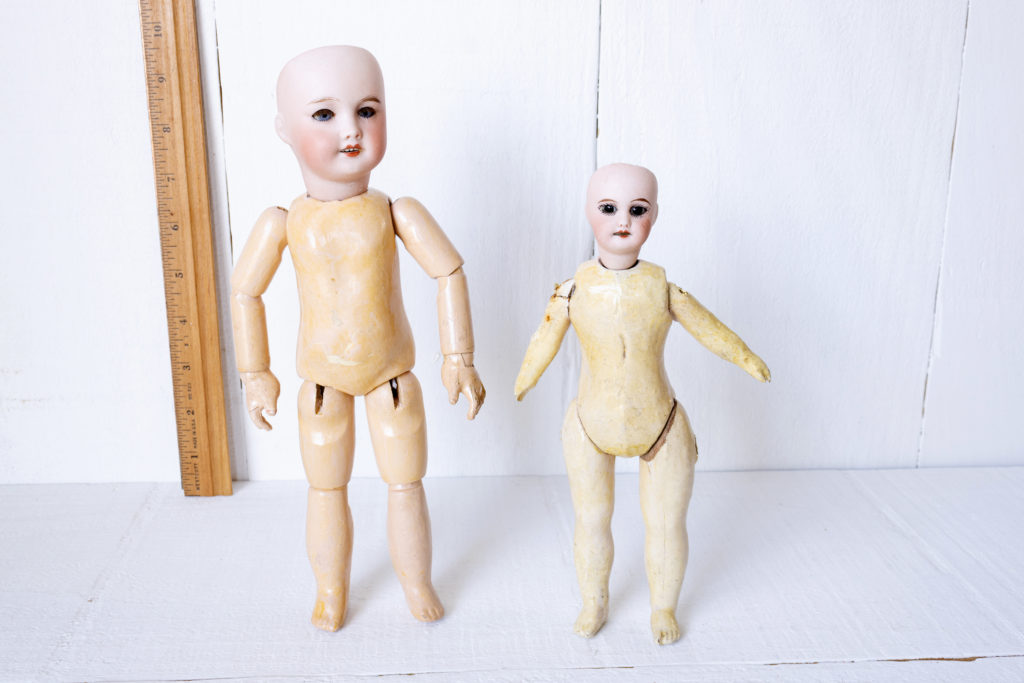
SFBJ 301 Paris Doll with Painted Eyes and Baby Shaped Body
Below was a unique SFBJ 301 Paris Doll with painted eyes and a nature baby body form surprised me in one of my doll lot auction wins. Is the head original to the body? I don’t know. The doll is only about six inches long. The face, though, is definitely a typical 301. The bisque head bears the usual circular SFBJ 301 Paris mark with a head size marked as 4/0. I have begun to believe the head sizes smaller than 1 are those with the fraction slash zero number sizes.
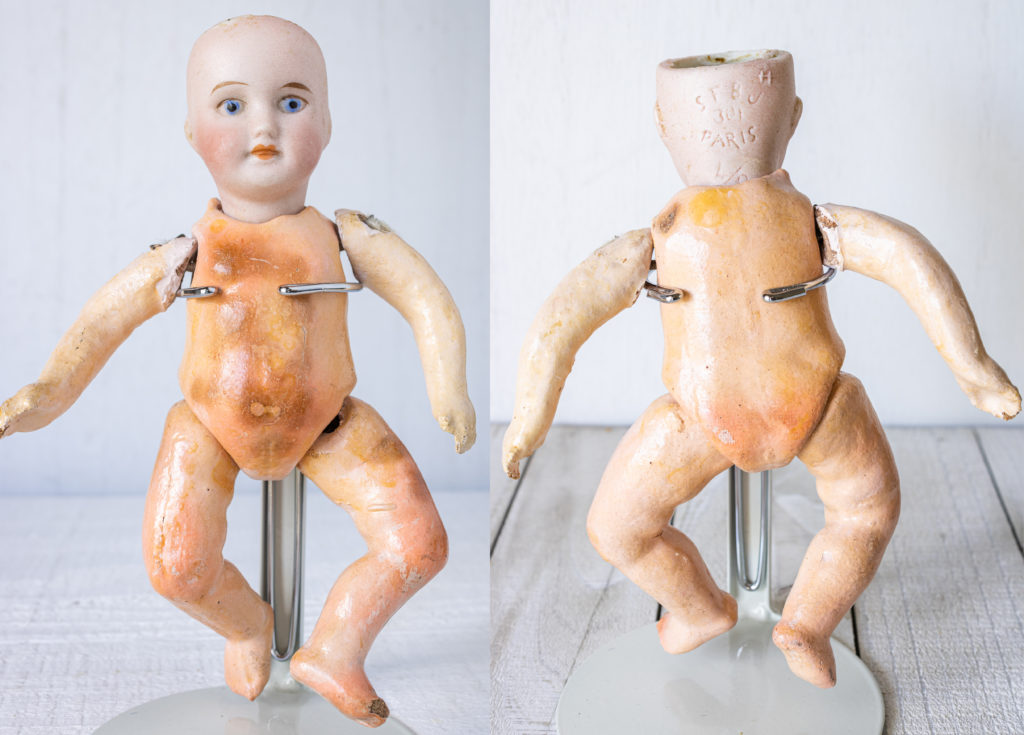
See other French doll marks here.
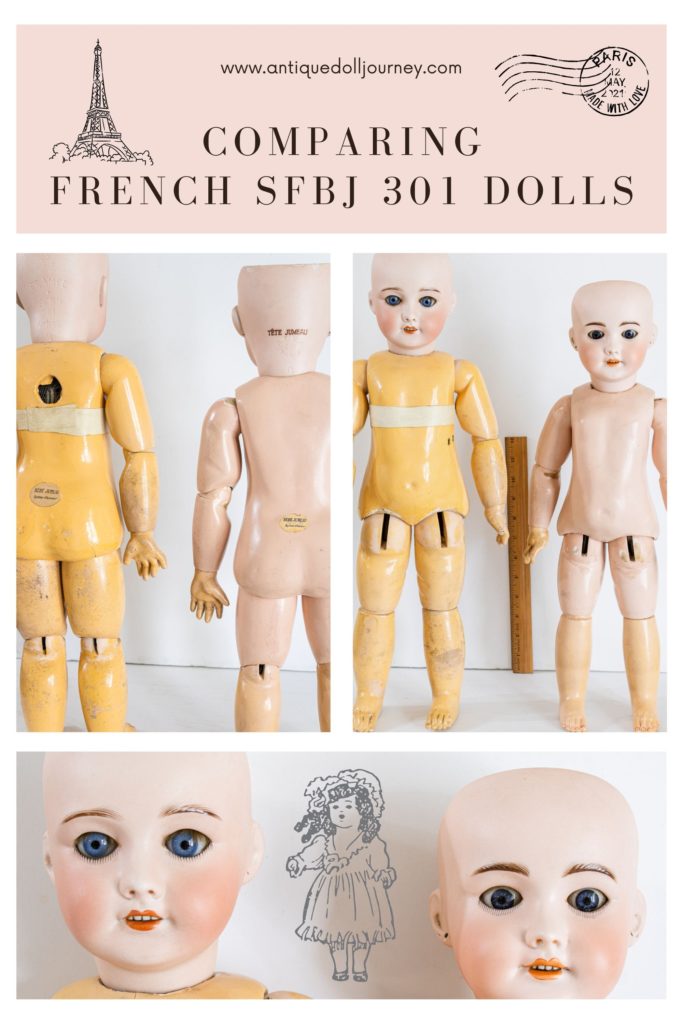
See some French doll shoe markings here.
